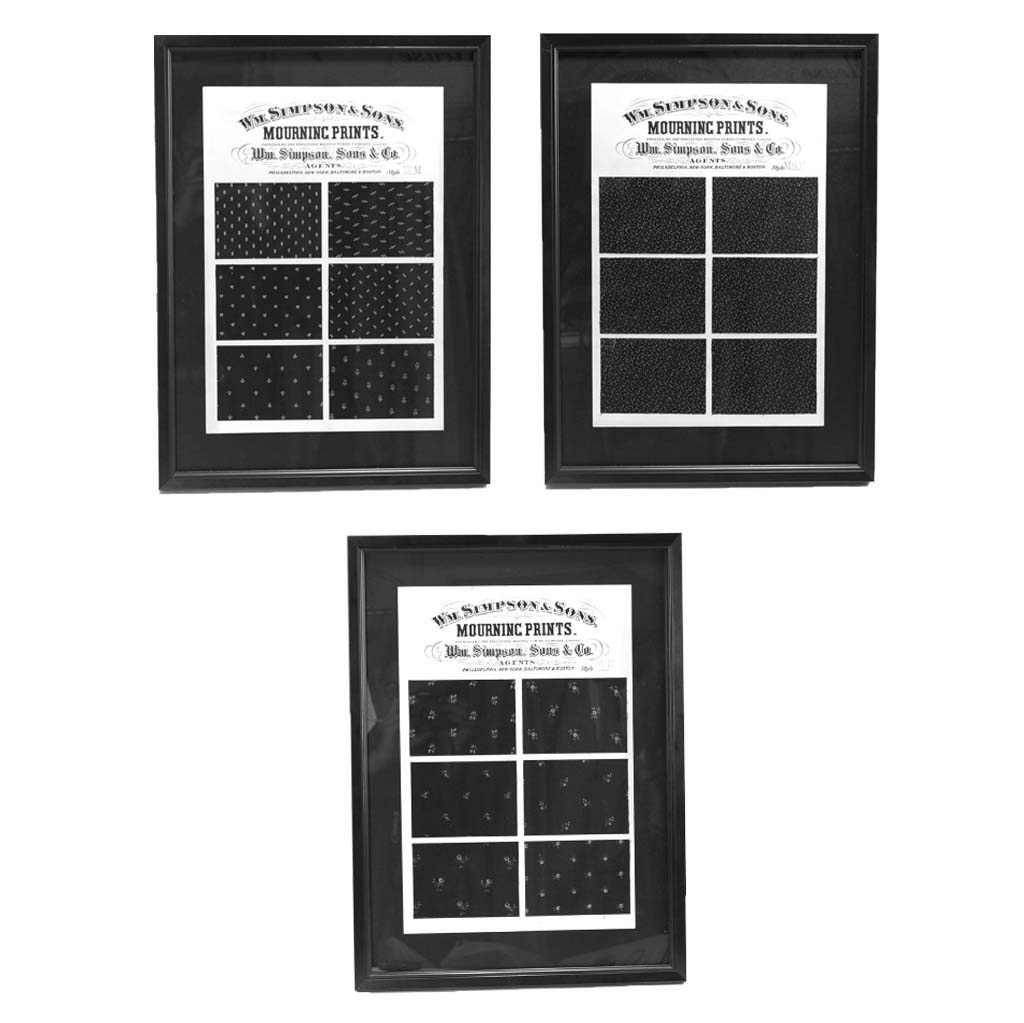Sold: Mourning Prints
Antique “Mourning Prints” swatch pages from a dressmaker’s book, c. 1870s. Each page has six printed cotton swatches which would have been offered to women as choices for mourning dress. The fabric was printed by the Eddystone Manufacturing Company, Ltd., which was formed in 1877 in Eddystone, Pennsylvania, where it operated a cotton prints factory.
Queen Victoria ushered in the intricate rituals of mourning dress with the death of her husband, Prince Albert, in 1861. Victoria wore “widow’s weeds” until her death in 1901, and following the royal trend, both the upper and middle classes of bought into the conspicuous consumption of prolonged sorrow. Victorian mourning etiquette not only demanded elaborate funerary rituals and the curtailment of social activities, it also mandated that a woman’s sadness be reflected in the objects around her, extending beyond clothing to details such as black leatherbound prayer books and black-edged stationery.
Clothing was of course the chief and most complicated element of material mourning, however. The mourning period and type of mourning dress appropriate for a given death depended on the closeness of relation, and popular manuals for housewives standardized grief protocol, whether it be for the death of a first child (one year of mourning) or first cousin (four weeks). Social norms required women to undergo two and a half years of mourning after the death of a husband. For the duration, women were expected to wear black, although as widows moved from transitional mourning dress to half mourning, acceptable fabrics slowly emerged from darkness into light. After a mourning period expired, it was considered bad luck to keep the morbid clothes in the house, and so each death demanded another trip to the dressmaker and milliner, making death a profitable business for those in the trade.
The fabric swatches here map the route of Victorian mourning (and one of the last trips to the dressmaker). Printed with a black ground with subtle patterns in white, the fabrics herald the coming light at the end of a long and dark period of grief, whether felt or feigned. When we perceive a printed fabric, we take the pattern as a superimposed layer, but the white pattern here is not added, but subtracted – it is the absence of black ink. Whether willfully sought or socially coerced, the widow submits her body and perhaps also soul to be cloaked in darkness, with only the faint pinpricks of her inherent light allowed to escape. What inverted silhouette does she choose?
Several swatches have regimented, angular patterns, which have the rigidity of chainmail. Does the widow wearing this dress endorse or lampoon the hallowed or hollow rituals of mourning? In other swatches, shadow flowers float on the fabric, as if carried on a black river or glowing in a moonlit garden. Is this widow’s love dead or alive? Is she reaching towards drowned petals in dark eddies or simply yearning for sunrise, tolerating a perfunctory night?
But take another of the pages, this one inexplicably pasted with six identical swatches. Or are they? In each, countless pinpricks of light pierce the black, but the varied constellations in each square of fabric seem to reveal a distinct universe. Staring at the starry swatches is dizzying, like looking too deeply up into the night sky. Was she finding solace in a universe of light or becoming weightless in an infinite void? From the cold earth beside her husband’s tombstone, she looked to the inked night on her sleeve, printed with a promise of heaven or the semblance of oblivion.
Condition
Excellent condition and professionally framed.
Shipping
Free in the continental United States. If an international buyer, please contact me for a shipping estimate by clicking here.
























